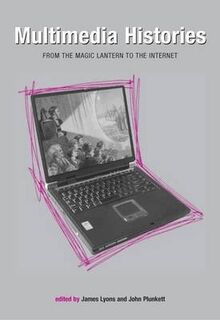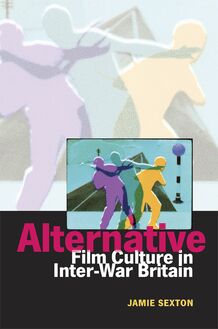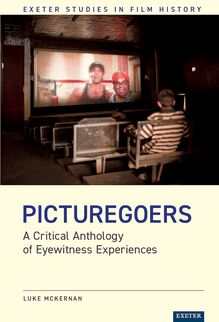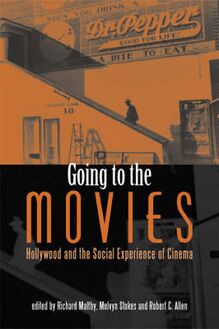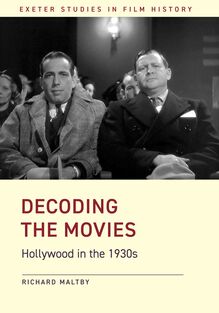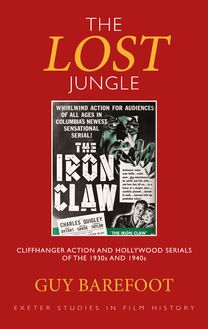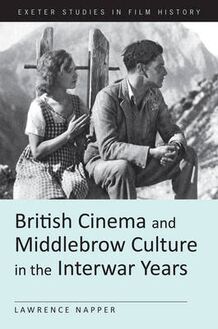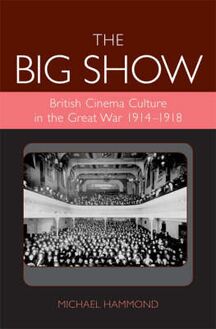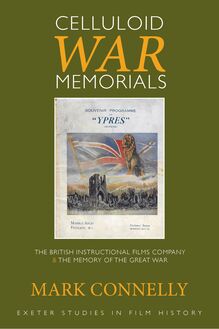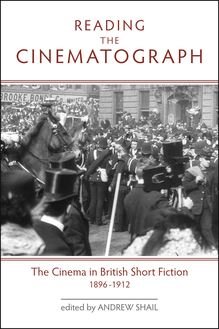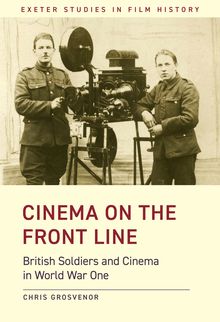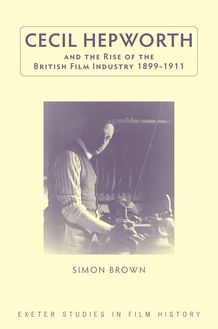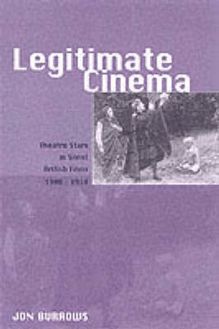-
 Univers
Univers
-
 Ebooks
Ebooks
-
 Livres audio
Livres audio
-
 Presse
Presse
-
 Podcasts
Podcasts
-
 BD
BD
-
 Documents
Documents
-
- Cours
- Révisions
- Ressources pédagogiques
- Sciences de l’éducation
- Manuels scolaires
- Langues
- Travaux de classe
- Annales de BEP
- Etudes supérieures
- Maternelle et primaire
- Fiches de lecture
- Orientation scolaire
- Méthodologie
- Corrigés de devoir
- Annales d’examens et concours
- Annales du bac
- Annales du brevet
- Rapports de stage
La lecture à portée de main
Vous pourrez modifier la taille du texte de cet ouvrage
Découvre YouScribe en t'inscrivant gratuitement
Je m'inscrisDécouvre YouScribe en t'inscrivant gratuitement
Je m'inscrisEn savoir plus
Vous pourrez modifier la taille du texte de cet ouvrage
En savoir plus

Description
This book “decodes” 1930s Hollywood movies and explains why they looked and behaved in the way they did. Organized through a series of related case studies, the book exposes Classical Hollywood movies to a detailed analysis of their historical, industrial and cultural contexts. In the process it utilizes industry data, aesthetic analysis and the insights of New Cinema History to explain why and how these movies assumed their familiar forms.
The book represents the summation of Richard Maltby’s four decades of scholarship in the field of Hollywood cinema. The essays presented here share an assumption that has increasingly informed the author’s critical method over the years: that any historical understanding of the films of this period requires a deep contextualization in the social circumstances surrounding both their production and consumption. In this way, the book introduces an innovative, overarching research methodology that synthesizes branches of research that are typically employed in isolation, including production, distribution, reception, film aesthetics, and cultural and historical context.
Of the book’s nine chapters, three are presented here for the first time, and four have been substantially revised and extended from their original publication.
Part 1: Decodings
Introduction: “What the Hell, It’s Only History …”
2 “A Brief Romantic Interlude”: Dick and Jane Go To Threeand- a-Half Seconds of the Classical Hollywood Cinema
3 “As Close to Real Life as Hollywood Ever Gets”: Headline Pictures, Topical Movies, Editorial Cinema and Studio Realism in the 1930s
Part 2: Patriarchs
4 “Just Another Good Program Picture from Warners”: The Misadventures of Barbara Stanwyck and Friedrich Nietzsche at Warner Bros., 1933
5 Clark Gable, the Production Code and the Recreation of the Patriarch: It Happened One Night
6 Sex and Shirley Temple
Part 3: Criminals
7 Criminal Entertainers: Al Capone, Howard Hughes and the Production Code
8 “Gangland as It Really Is”: James Cagney, Horatio Alger and the Natural History of Delinquent Careers
9 “Any Resemblance to Actual Persons, Living or Dead …”: Martin Mooney, Edward G. Robinson and the Incorporation of Dutch Schultz
10 Afterword
Notes
Select Bibliography
Index
Sujets
Informations
| Publié par | University of Exeter Press |
| Date de parution | 15 mars 2021 |
| Nombre de lectures | 0 |
| EAN13 | 9781905816453 |
| Langue | English |
| Poids de l'ouvrage | 2 Mo |
Informations légales : prix de location à la page 0,7650€. Cette information est donnée uniquement à titre indicatif conformément à la législation en vigueur.
Extrait
Decoding the Movies
This book “decodes” 1930s Hollywood movies and explains why they look and behave in the way that they do. Through a series of case studies, it exposes Classical Hollywood films to a detailed analysis of their historical, industrial and cultural contexts. In the process the book utilizes industry data, aesthetic analysis and the insights of New Cinema History to explain why and how these movies assumed their familiar forms.
Decoding the Movies represents the summation of Richard Maltby’s four decades of scholarship in the field of Hollywood cinema. The chapters presented here share a concept that has increasingly informed the author’s critical method over the years: that any historical understanding of the films of this period requires deep contextualization of the social circumstances surrounding both their production and consumption. In this way, the book introduces an innovative, overarching research methodology that synthesizes branches of research that are typically employed in isolation—including production, distribution, reception, film aesthetics, and cultural and historical context.
Richard Maltby is the Matthew Flinders Distinguished Emeritus Professor of Screen Studies at Flinders University, Adelaide. A Fellow of the Australian Academy of the Humanities, he has published extensively on the cultural history of Hollywood and edited eight books on the history of cinema audiences, exhibition and reception, including Going to the Movies: Hollywood and the Social Experience of Cinema (UEP, 2007; coedited with Melvyn Stokes and Robert C. Allen). He is a Series Editor for Exeter Studies in Film History.
Exeter Studies in Film History
Series Editors:
Richard Maltby , Matthew Flinders Distinguished Emeritus Professor of Screen Studies, Flinders University
Helen Hanson , Associate Professor in Film History at the University of Exeter and Academic Director of the Bill Douglas Cinema Museum
Joe Kember , Professor in Film Studies at the University of Exeter
Exeter Studies in Film History is devoted to publishing the best new scholarship on the cultural, technical and aesthetic history of cinema. The aims of the series are to reconsider established orthodoxies and to revise our understanding of cinema’s past by shedding light on neglected areas in film history.
Published by University of Exeter Press in association with the Bill Douglas Centre for the History of Cinema and Popular Culture, the series includes monographs and essay collections, translations of major works written in other languages, and reprinted editions of important texts in cinema history.
Previously published titles in the series are listed at the back of this volume
Decoding the Movies
Hollywood in the 1930s
Richard Maltby
First published in 2021 by
University of Exeter Press
Reed Hall, Streatham Drive
Exeter EX4 4QR
UK
www.exeterpress.co.uk
© Richard Maltby 2021
The right of Richard Maltby to be identified as author of this work has been asserted by him in accordance with the Copyright, Designs and Patents Act 1988.
Exeter Studies in Film History
British Library Cataloguing in Publication Data
A catalogue record for this book is available from the British Library.
Hbk ISBN 978 190581 644 6
ePub ISBN 978 190581 645 3
PDF ISBN 978 190581 646 0
Cover image: Humphrey Bogart and Barton MacLean in Bullets or Ballots (Warner Bros., 1936).
Typeset in Caslon by BBR Design, Sheffield
For Ruth and Ben
Contents
List of Illustrations
Acknowledgements
Part 1: Decodings
1 Introduction: “What the Hell, It’s Only History …”
2 “A Brief Romantic Interlude”: Dick and Jane Go To Three-and-a-Half Seconds of the Classical Hollywood Cinema
3 “As Close to Real Life as Hollywood Ever Gets”: Headline Pictures, Topical Movies, Editorial Cinema and Studio Realism in the 1930s
Part 2: Patriarchs
4 “Just Another Good Program Picture from Warners”: The Misadventures of Barbara Stanwyck and Friedrich Nietzsche at Warner Bros., 1933
5 Clark Gable, the Production Code and the Recreation of the Patriarch: It Happened One Night
6 Sex and Shirley Temple
Part 3: Criminals
7 Criminal Entertainers: Al Capone, Howard Hughes and the Production Code
8 “Gangland as It Really Is”: James Cagney, Horatio Alger and the Natural History of Delinquent Careers
9 “Any Resemblance to Actual Persons, Living or Dead …”: Martin Mooney, Edward G. Robinson and the Incorporation of Dutch Schultz
10 Afterword
Notes
Select Bibliography
Index
Illustrations
2.1 Casablanca ’s airport tower scene
3.1 Advert for I Am a Fugitive from a Chain Gang
3.2 Warner Bros. advertises its topical pictures
3.3 Black Legion ’s pressbook
3.4 Black Legion ’s Midwestern citizens
4.1 Cragg the dispenser of patriarchal platitudes
4.2 Warner Bros. advert
4.3 Passage paraphrasing H.L. Mencken
4.4 Barbara Stanwyck
5.1 Clark Gable
6.1 Shirley Temple’s first appearance
6.2 The Baby Burlesks
6.3 Fox promotion of Temple
7.1 Movie Classic and gang culture
7.2 Scarface poster
7.3 Film Daily ’s advert for Scarface
7.4 Los Angeles Times advert for Scarface
9.1 Adverts for Bullets or Ballots and Parole!
9.2 Black Legion ’s disclaimer
9.3 Bullets or Ballots ’ advertising
9.4 Martin Mooney in the International Motion Picture Almanac
9.5 The directors of incorporated crime in Bullets or Ballots
(Illustrations provided from the author’s collection)
Acknowledgements
This book has been very long in gestation. Its origins lie in an American Studies Fellowship awarded by the American Council of Learned Societies which I held at the University of Wisconsin Madison in 1983–84. There I had the great good fortune to work for the first time with Tino Balio, David Bordwell, Kristin Thompson, Lea Jacobs and Matthew Bernstein, who have remained valued friends, hosts, guests and sparring partners over the years. The same fellowship gave me the freedom to travel across the USA, where I first discovered the indispensable archives to which I would return many times in the ensuing years. I spent three months examining the Production Code Administration archive held by the Margaret Herrick Library of the Academy of Motion Picture Arts and Sciences, Los Angeles, where I was greatly helped by archivists Sam Gill, Howard Prouty and Barbara Hall. Leith Adams and Ned Comstock guided me through the Warner Bros. Archive at the University of Southern California. I am greatly indebted to James Bouras of the Motion Picture Association of America for permitting me to consult documents in the MPA archive in New York, and to Caroline Stein for her help in accessing the archive; to Maxine Fleckner Ducey and the staff of the Center for Film and Theater Research at Madison, Father William Barnaby Faherty, SJ and Mrs. Nancy Merz of the Jesuit Missouri Province Archives, St. Louis, Missouri; to John Hall of the RKO Archive, Los Angeles, and to Karen Rench of the Indiana State Library. More recently, along with every other historian of Hollywood, I owe an enormous debt to David Pierce, Eric Hoyt and the curators of the Media History Digital Library ( http://mediahistoryproject.org ) for the trove of information they have made available.
My work has benefitted from the support of the University of Exeter, the British Academy, Flinders University, the Australian Research Council, the Australian Academy of the Humanities and the Australian National Data Service Seeding the Commons program, which facilitated the creation of the MPPDA Digital Archive ( https://mppda.flinders.edu.au ), central to much of the research presented here.
Many colleagues across the world of Screen Studies have contributed to the development of the ideas in these chapters, and I am grateful to them for having made the whole writing process infinitely more convivial and enjoyable. Among them are Robert Allen, Melvyn Stokes, Steve Neale, Peter Stanfield, Kathy Fuller-Seeley, Giuliana Muscio, Tom Schatz, Greg Waller, Barbara Klinger, Janet Staiger, Douglas Gomery, Richard Abel, Francis Couvares, Richard Butsch, Arthur Knight, Clayton Koppes, Tom Ryall, Annette Kuhn, Andrew Higson, Lee Grieveson, Peter Stanfield, John Sedgwick, Martin Barker, Peter Krämer, Ben Brewster, Daniel Biltereyst, Philippe Meers, Judith Thissen, Kate Bowles, Paul Moore, Jeff Klenotic, Clara Pafort-Overduin, Daniela Treveri Gennari, Catherine Jurca and the late Robert Sklar.
At the University of Exeter, where I worked between 1978 and 1995, I had the invaluable collegial support of Karen Edwards, Anthony Fothergill, Michael Wood, Ron Tamplin, Peter Quartermaine, Richard Bradbury, Jo Seton, Ian Craven, the late Chris Brooks, the late Gareth Roberts, and most especially Mick Gidley, mentor and exemplar. At Flinders University, where I have been based since 1997, I have been very grateful for the friendship and inspiration of colleagues Mike Walsh, Julia Erhart, Nick Prescott, Nick Godfrey, Graham Tulloch, Robert Phiddian, Diana Glenn, Julian Meyrick and my other mentor, the late Faith Trent.
At the University of Exeter Press, Simon Baker sparked the idea for this book, and he and Helen Gannon helped shape it. Anna Henderson, Nigel Massen and David Hawkins have brought it to completion. Matthew Bernstein provided an extremely helpful commentary on the manuscript. I also thank my co-editors of Exeter Studies in Film History , Helen Hanson and Joe Kember.
Finally, my greatest debt, intellectual and much more, is to Ruth Vasey, who shared this book’s gestation and tempered its worst excesses. Of all the gin joints in all the towns in all the world …
Chapter 2 , “‘A Brief Romantic Interlude’: Dick and Jane Go to Three-and-a-Half Seconds of the Classical Hollywood Cinema,” was originally published in Post-Theory: Reconstructing Film Studies , edited by David Bordwell and Noel Carroll (University of Wisconsin Press, 1996), pp. 434–59. Reprinted courtesy of The University of Wisconsin Press. © 1996 The B
-
 Univers
Univers
-
 Ebooks
Ebooks
-
 Livres audio
Livres audio
-
 Presse
Presse
-
 Podcasts
Podcasts
-
 BD
BD
-
 Documents
Documents
-
Jeunesse
-
Littérature
-
Ressources professionnelles
-
Santé et bien-être
-
Savoirs
-
Education
-
Loisirs et hobbies
-
Art, musique et cinéma
-
Actualité et débat de société
-
Jeunesse
-
Littérature
-
Ressources professionnelles
-
Santé et bien-être
-
Savoirs
-
Education
-
Loisirs et hobbies
-
Art, musique et cinéma
-
Actualité et débat de société
-
Actualités
-
Lifestyle
-
Presse jeunesse
-
Presse professionnelle
-
Pratique
-
Presse sportive
-
Presse internationale
-
Culture & Médias
-
Action et Aventures
-
Science-fiction et Fantasy
-
Société
-
Jeunesse
-
Littérature
-
Ressources professionnelles
-
Santé et bien-être
-
Savoirs
-
Education
-
Loisirs et hobbies
-
Art, musique et cinéma
-
Actualité et débat de société
- Cours
- Révisions
- Ressources pédagogiques
- Sciences de l’éducation
- Manuels scolaires
- Langues
- Travaux de classe
- Annales de BEP
- Etudes supérieures
- Maternelle et primaire
- Fiches de lecture
- Orientation scolaire
- Méthodologie
- Corrigés de devoir
- Annales d’examens et concours
- Annales du bac
- Annales du brevet
- Rapports de stage
